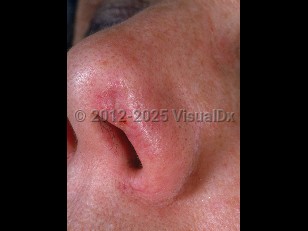Microcystic adnexal carcinoma
Alerts and Notices
Important News & Links
Synopsis

Microcystic adnexal carcinoma, or MAC, is a rare, locally aggressive adnexal carcinoma believed to be derived from a pluripotent adnexal keratinocyte, which may display ductal and follicular differentiation.
It usually affects young or middle-aged adults in the fourth to sixth decades of life, and an age range of 11 to 90 years has been reported. Most cases have been reported in individuals of Northern European descent (90%); however, there have been reports in people of Asian, Latino, and African descent. Both sexes are affected, but a slight female predilection is seen.
The tumor is most commonly seen on the head and neck, with a predilection for the centrofacial area including the upper and lower lips. Other locations where it has been identified include the trunk, buttocks, and axilla. It is typically solitary; however, multiple lesions have been reported. Sun exposure may be a possible risk factor, given that most cases are on the head and neck and more cases were seen on the left side of the head / neck in a US-based study. Previous history of radiation and immunosuppression are further apparent risk factors.
MAC is typically indolent and asymptomatic with a clinically benign appearance, and the entity is therefore notorious for misdiagnosis. The median size at diagnosis is approximately 2 cm, with a range of 0.03-16 cm. About half of MACs demonstrate perineural invasion, local recurrence, and extension into the sinus cavity. When this occurs, symptoms such as paresthesias, pain, burning, feeling of fullness, numbness, and nerve palsies may develop. Metastasis, albeit rare, has been reported to skin, lymph nodes, and lung and may be more common in immunosuppressed individuals. Overall 5-year survival is 98%.
It usually affects young or middle-aged adults in the fourth to sixth decades of life, and an age range of 11 to 90 years has been reported. Most cases have been reported in individuals of Northern European descent (90%); however, there have been reports in people of Asian, Latino, and African descent. Both sexes are affected, but a slight female predilection is seen.
The tumor is most commonly seen on the head and neck, with a predilection for the centrofacial area including the upper and lower lips. Other locations where it has been identified include the trunk, buttocks, and axilla. It is typically solitary; however, multiple lesions have been reported. Sun exposure may be a possible risk factor, given that most cases are on the head and neck and more cases were seen on the left side of the head / neck in a US-based study. Previous history of radiation and immunosuppression are further apparent risk factors.
MAC is typically indolent and asymptomatic with a clinically benign appearance, and the entity is therefore notorious for misdiagnosis. The median size at diagnosis is approximately 2 cm, with a range of 0.03-16 cm. About half of MACs demonstrate perineural invasion, local recurrence, and extension into the sinus cavity. When this occurs, symptoms such as paresthesias, pain, burning, feeling of fullness, numbness, and nerve palsies may develop. Metastasis, albeit rare, has been reported to skin, lymph nodes, and lung and may be more common in immunosuppressed individuals. Overall 5-year survival is 98%.
Codes
ICD10CM:
D09.8 – Carcinoma in situ of other specified sites
SNOMEDCT:
254712007 – Microcystic adnexal carcinoma
D09.8 – Carcinoma in situ of other specified sites
SNOMEDCT:
254712007 – Microcystic adnexal carcinoma
Look For
Subscription Required
Diagnostic Pearls
Subscription Required
Differential Diagnosis & Pitfalls

To perform a comparison, select diagnoses from the classic differential
Subscription Required
Best Tests
Subscription Required
Management Pearls
Subscription Required
Therapy
Subscription Required
References
Subscription Required
Last Reviewed:06/20/2018
Last Updated:08/28/2023
Last Updated:08/28/2023
Microcystic adnexal carcinoma

